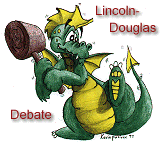
Types
A proposition is the claim, proposal, conclusion, or resolution that is being debated, e.g. Resolved: the exploration of space is essential to a strong defense. Propositions, otherwise known as resolutions, are the topics that will be debated.
Ideally, high school debaters should only debate propositions of value or propositions of comparison. However, in reality, they will encounter all four types. Propositions of policy present a special problem because many debaters feel obligated to debate this type of resolution using a policy debate format, i.e. inherency, solvency, and disadvantages. Once again, a prepared debater will understand that value debate seeks a generalized approach or attitude, not a specific plan that seeks to solve the problem.
The Proposition of Fact -- a statement that something is true.
- Resolved: That A is true.
- Resolved: That genetic manipulation of nature will lead to incurable diseases.
- Resolved: That uniformity in education will lead to mediocrity.
The Proposition of Value -- a statement that something is desirable or undesirable.
- Resolved: That A is good.
- Resolved: That the genetic manipulation of nature is immoral.
- Resolved: That uniformity in education is desirable.
The Proposition of Policy --a statement promoting a certain course of action.
- Resolved: That A should be done.
- Resolved: That genetic manipulation of nature should have a higher priority in federally supported research programs.
- Resolved: That uniformity in education should be established through national standards.
The Proposition Of Comparison - a statement comparing two items.
- Resolved: That A is better than B.
- Resolved: That the benefits of genetic manipulation of nature outweigh the risks.
- Resolved: That uniformity in education is better than individuality.
Components
There are two basic components to a proposition - the subject of the propositional sentence and the predicate. Each part serves a specific role.
- The Subject of Evaluation is the subject of the proposition sentence.
- The Terms of Evaluation is the concept used to judge the Subject of Evaluation.
- Resolved: That the genetic manipulation of nature is immoral.
- SUBJECT OF EVALUATION: genetic manipulation of nature
- TERMS OF EVALUATION: immoral.
- Resolved: That genetic
manipulation of nature should have a higher priority in federally supported research
programs.
- SUBJECT OF EVALUATION: genetic manipulation of nature
- TERMS OF EVALUATION: higher priority
- Resolved: That the
benefits of genetic manipulation of nature outweigh the risks.
- SUBJECT OF EVALUATION: genetic manipulation of nature
- TERMS OF EVALUATION: outweighs risks
Analysis
When a debater first receives the proposition, he should strive for a basic, generalized understanding of the topic before he begins an in-depth analysis. It is recommended that the following three steps be accomplished first.
- Definition of Key Terms: In order
to gain a clear understanding of what will be debated, each key term in the proposition
must be defined. A generalized dictionary, such as Webster's, is sufficient for
this initial analysis.
- Resolved: That the benefits of genetic manipulation of nature outweigh the risks.
- BENEFITS - something that guards, aids, or promotes well being
- GENETIC MANIPULATION - the act of manually altering genetic characteristics or qualities
- OUTWEIGH - to exceed in weight, value, or importance
- RISKS - the possibility of loss, injury, disadvantage, or destruction
- Generalized Research: In order to gain an overall understanding of why this particular topic was chosen, a debater should do a generalized search for related articles in national magazines such as Newsweek, Time, and U.S. News & World Report. The debater should not take notes or write evidence cards at this point. The purpose of this step is to gain understanding.
- Analogies Examples, And Discussion. The third step in the initial analysis is to gain a feeling of how the topic is perceived by others, how it relates to real life, and how other people feel about the issues. This understanding will enable the debater to gain a sensitivity of how a judge may react to arguments presented in the round.
Application
In order to solidify your understanding of how propositions are constructed, complete the following exercise.
- Write two examples for each type of proposition; fact,value,policy, & comparison.
- Break each of the resolutions into Objects of Evaluations and Terms of Evaluations.
Define the key terms in each proposition.